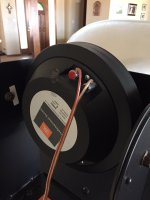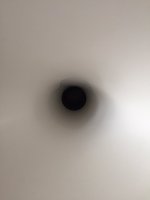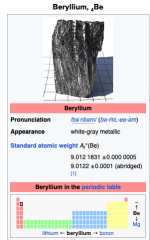" Is there something special about heat treated aluminum?"
Yes, you found it- "These Renkus Heinz tweeters seem to perform nearly as well as beryllium, at 15% of the cost."
Yes, you found it- "These Renkus Heinz tweeters seem to perform nearly as well as beryllium, at 15% of the cost."
Most aluminum (al-lu-minium, as my English educated Indian mettalurgy/materials science professor used to say), metals used for engineering applications are alloys, as you know.
Among the alloy materials commonly used are copper and beryllium. These alloying ingredients affect the crystal structure, which affect the engineering products manufactured from the aluminum alloy. We don't generally use pure aluminum because it is too soft, doesn't machine well, and weldability, for example. Modern aircraft wouldn't be possible/economically feasible using other materials. A titanium or copper airplane would be very expensive, financially impractical. Look at the price of a titanium bicycle frame. (I can remember how my professor pronounced titanium...)
In the mechanical engineering world, the best springs are made from a Cu-Be alloy. The disadvantage of Be is that for some people, Be can be toxic and some people exposed to Be processing develop a disease called Berylliosis. Like lead and other heavy metals, once ingested or inhaled during exposure, it remains in the body. Some people can tolerate exposure and don't develop sensitivity or the disease. Only way to know if you are sensitive is by exposure. By exposure, I mean those involved with beryllium/products, such as welding, casting, etc. (I am not saying that having speaker drivers containing beryllium will result in berylliosis.)
I really wish I could hear the difference between a aluminum/beryllium compression driver versus a aluminum alloy compression driver. But I can't. Even though I have Al/Be compression drivers.
.
Among the alloy materials commonly used are copper and beryllium. These alloying ingredients affect the crystal structure, which affect the engineering products manufactured from the aluminum alloy. We don't generally use pure aluminum because it is too soft, doesn't machine well, and weldability, for example. Modern aircraft wouldn't be possible/economically feasible using other materials. A titanium or copper airplane would be very expensive, financially impractical. Look at the price of a titanium bicycle frame. (I can remember how my professor pronounced titanium...)
In the mechanical engineering world, the best springs are made from a Cu-Be alloy. The disadvantage of Be is that for some people, Be can be toxic and some people exposed to Be processing develop a disease called Berylliosis. Like lead and other heavy metals, once ingested or inhaled during exposure, it remains in the body. Some people can tolerate exposure and don't develop sensitivity or the disease. Only way to know if you are sensitive is by exposure. By exposure, I mean those involved with beryllium/products, such as welding, casting, etc. (I am not saying that having speaker drivers containing beryllium will result in berylliosis.)
I really wish I could hear the difference between a aluminum/beryllium compression driver versus a aluminum alloy compression driver. But I can't. Even though I have Al/Be compression drivers.
.
Attachments
In this paper the Al diaphragm is very close in performance (In my opinion) to the Be apart from in HF output where the Be has a clear advantage. The Al diaphragm drivers I have heard in real life all sounded great.
Attachments
The CDX series from Celestion (3 of them) also are Aluminum alloy w/ poly surround, but they aren’t large format drivers with extended lower freq. response. Still, they might work very well in this (Unity) context.AFAIK, Radian is the only manufacturer who makes aluminum compression drivers.
Military trucks used EN-47 (SAE /AISI 6150) leaf springs, don't break as easily as EN-45 / 45A (SAE 9255) springs.
Particularly in the main and main wrapper - 2nd leaf, which is to take the load if the main leaf breaks.
EN 45 / 45A are Silico-Manganese steels, 47 is a chrome vanadium steel.
Copper Beryllium alloy is used in relays, leaf switches and so on. Mostly for flat sections, rarely in coil springs.
Here the common ingredients in Aluminum alloys included Silicon, aand others like Zinc.
Carburetors were made in 'Mazak', a hard wearing Al-Zn alloy. Good for areas where the slide moved.
I used to work at my uncle's leaf spring plant in college vacations....He was in leaf springs from 1962 to 2012, 50 years, built three factories, civil to machinery to tooling.
So I can claim hands- on and learned knowledge, for example how to repair a power press cast iron gear tooth.
Particularly in the main and main wrapper - 2nd leaf, which is to take the load if the main leaf breaks.
EN 45 / 45A are Silico-Manganese steels, 47 is a chrome vanadium steel.
Copper Beryllium alloy is used in relays, leaf switches and so on. Mostly for flat sections, rarely in coil springs.
Here the common ingredients in Aluminum alloys included Silicon, aand others like Zinc.
Carburetors were made in 'Mazak', a hard wearing Al-Zn alloy. Good for areas where the slide moved.
I used to work at my uncle's leaf spring plant in college vacations....He was in leaf springs from 1962 to 2012, 50 years, built three factories, civil to machinery to tooling.
So I can claim hands- on and learned knowledge, for example how to repair a power press cast iron gear tooth.
Last edited:
I rather doubt that titanium is being machined to form driver diaphragms.Aluminum may not age as well as Titanium .
Titanium has to be machined in a controlled atmosphere (It can burn in air, and dangerously fast), beryllium can go brittle.
If you get aircraft grade corrosion resistant Aluminum alloy, go for it...otherwise Titanium, or other materials mentioned above.
BTW, Polyamide is the technical name for Nylon, similar to what is used in stockings etc.
Type writer daisy wheels, engine intake manifolds, and many other parts are made from that family of materials,PA - 6 and 6/6 are the most common.
It's more the specific modulus and self-damping of the material than anything else, when it comes to resonance. A material can be less dense but start ringing earlier because it has much less stiffness for its weight, or vice versa. That's why carbon fiber, Be, and (maybe not too surprisingly) balsa wood can make excellent rigid diaphragms.The density and audio behavior of different materials are different subjects in my opinion.
Be- 185 g / cc
Al - 2.7 g/ cc
Ti - 4.50 g / cc
Fe -7.86 g /cc
If you take a flat disk, and make it vibrate, like the old school phone speakers, guess what?
Al will sound different from steel.... so it is a function of the tensile strength and thickness as well.
Aluminum alloys are a vast field by themselves, and some are very specific, aircraft grade special property alloys are expensive and not easily available.
As an aside, anybody heard of Kevlar and other synthetic materials in this application?
Sort the list "Young's modulus per density cubed (m8kg−2s−2)" here: https://en.wikipedia.org/wiki/Specific_modulus
From my Post #17:
"The density and audio behavior of different materials are different subjects in my opinion."
And...
'If you take a flat disk, and make it vibrate, like the old school phone speakers, guess what?
Al will sound different from steel.... so it is a function of the tensile strength and thickness as well.'
There are people who pay too much for a fuse.
So if a Titanium audio part is offered, some people will pay, just because they can.
Their money, their decision.
I am waiting to see if 3-D printed speaker parts made of Aluminum are available...
"The density and audio behavior of different materials are different subjects in my opinion."
And...
'If you take a flat disk, and make it vibrate, like the old school phone speakers, guess what?
Al will sound different from steel.... so it is a function of the tensile strength and thickness as well.'
There are people who pay too much for a fuse.
So if a Titanium audio part is offered, some people will pay, just because they can.
Their money, their decision.
I am waiting to see if 3-D printed speaker parts made of Aluminum are available...
Tensile strength doesn't have anything to do with it, unless the material is so weak it undergoes plastic strain (deformation) during its movement.
Steel is stiffer, and stronger than Aluminum, is it not?
A Magnesium alloy wheel, compared to a plain Aluminum wheel?
You think they will have the same audio frequency spectrum response when excited, say in the simple diaphragm type phone ear piece?
In any case, that is going slightly off topic.
Young's modulus is: the ratio of tensile stress (σ) to tensile strain (ε).
That tells you a little of the material's behavior.
The Wiki link is interesting, saw Titanium foam in the list...
The issue is the practicality of using most of the available materials in speakers, we need mass produced parts from a narrow range of available materials.
A Magnesium alloy wheel, compared to a plain Aluminum wheel?
You think they will have the same audio frequency spectrum response when excited, say in the simple diaphragm type phone ear piece?
In any case, that is going slightly off topic.
Young's modulus is: the ratio of tensile stress (σ) to tensile strain (ε).
That tells you a little of the material's behavior.
The Wiki link is interesting, saw Titanium foam in the list...
The issue is the practicality of using most of the available materials in speakers, we need mass produced parts from a narrow range of available materials.
Last edited:
@454Casull is correct, specific modulus (stiffness to weight ratio) is the most relevant parameter which determines how appropriate a material is for use as a speaker diaphragm. Beryllium has the highest ratio of any material that can be easily formed into a cone or dome shape, and with beryllium, it is not that easy.
The paper material that is often used for speakers is not a strong material, and it is not very stiff, but it has a high stiffness to weight ratio, and this makes it well suited. It also has good self damping. An added feature is that the properties can be adjusted by various coatings. The point is that high strength is not required, nor is high stiffness. But a high stiffness to weight ratio IS required.
Aluminum is a very good material for speakers. Stiffness to weight ratio is very good (which is why we use it in aerospace). It is also cheap, and easy to manufacture.
The paper material that is often used for speakers is not a strong material, and it is not very stiff, but it has a high stiffness to weight ratio, and this makes it well suited. It also has good self damping. An added feature is that the properties can be adjusted by various coatings. The point is that high strength is not required, nor is high stiffness. But a high stiffness to weight ratio IS required.
Aluminum is a very good material for speakers. Stiffness to weight ratio is very good (which is why we use it in aerospace). It is also cheap, and easy to manufacture.
You can't form/machine/press/weld elemental beryllium and use it for a speaker diaphragm.
It is an alloying ingredient.
My opinion- no one is going to definitively define how a Be-Cu diaphragm sounds to me or anybody else. Just like nobody is going to solve fundamental physics problems on a diy audio website, solve world wide problems or imagine swirled peas. Okay, you can imagine whatever you want.
So, as Deadmau5 says at the beginning of the song "Moar Ghosts n Stuff": After I'm gone Your Earth will be free To live out its miserable span of existence as one of my satellites, and that's how it's going to be.
It is an alloying ingredient.
My opinion- no one is going to definitively define how a Be-Cu diaphragm sounds to me or anybody else. Just like nobody is going to solve fundamental physics problems on a diy audio website, solve world wide problems or imagine swirled peas. Okay, you can imagine whatever you want.
So, as Deadmau5 says at the beginning of the song "Moar Ghosts n Stuff": After I'm gone Your Earth will be free To live out its miserable span of existence as one of my satellites, and that's how it's going to be.
Attachments
As in paper cones, where there is a lot of experience, the paper quality and thickness will change the sound, the rest of the speaker remaining the same - meaning magnet, coil, speaker etc.
So trying to use materials that are not easy to form, or highly corrosion prone, will give you an expensive option.
That is what I was hinting at, the same part is easy to sell for $1, rather than $50, where it goes to magic nonsense, prove it territory.
It then becomes a speculative discussion.
Rolex sells in far lower volumes than Seiko and Citizen....and look up Miyota, and their volumes in watch movements.
Miyota is the parent company of Citizen, by far the largest watch movement maker (standard quality) in the world.
Citizen sales must be more than 10x Swatch, which is part of the ETA Group, which also owns Rolex, Omega and Tissot, among others.
No ties to any names above.
So trying to use materials that are not easy to form, or highly corrosion prone, will give you an expensive option.
That is what I was hinting at, the same part is easy to sell for $1, rather than $50, where it goes to magic nonsense, prove it territory.
It then becomes a speculative discussion.
Rolex sells in far lower volumes than Seiko and Citizen....and look up Miyota, and their volumes in watch movements.
Miyota is the parent company of Citizen, by far the largest watch movement maker (standard quality) in the world.
Citizen sales must be more than 10x Swatch, which is part of the ETA Group, which also owns Rolex, Omega and Tissot, among others.
No ties to any names above.
You can't? https://audioxpress.com/article/test-bench-eighteen-sound-nd4015be-beryllium-compression-driverYou can't form/machine/press/weld elemental beryllium and use it for a speaker diaphragm.
Why? You want to start building your own drivers?Please mention prices...
In comparison to a regular piezo or aluminum tweeter, are the prices of these drivers within range or astronomical?
I have no intention of arguing with impractical people.
You can build your own watches given enough time and money, or buy a good one.
In place of say $40, ready stock, somebody says $1000, 6 months...we should know about that as well, don't you think?
And the processes mentioned, vapor deposition or foil rolling, involve controlled atmosphere and very small runs.
Specialist stuff, so I ask prices...and I get this response!
Materion wants me to fill up a form, they will go through it and reply...
I have no intention of arguing with impractical people.
You can build your own watches given enough time and money, or buy a good one.
In place of say $40, ready stock, somebody says $1000, 6 months...we should know about that as well, don't you think?
And the processes mentioned, vapor deposition or foil rolling, involve controlled atmosphere and very small runs.
Specialist stuff, so I ask prices...and I get this response!
Materion wants me to fill up a form, they will go through it and reply...
- Home
- Loudspeakers
- Multi-Way
- Annealed Aluminum


